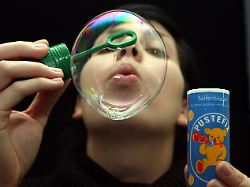75 years of Pustefix
Soap bubbles know no hype and no crises
05/28/2023 11:49 am
Soap bubbles burst quickly. Pustefix’s business, on the other hand, has been stable for 75 years now. The idea came about out of necessity. The recipe, which has remained secret to this day, was originally intended to serve a completely different purpose.
In art they stand for transience, in mathematics one admires their minimalism and for children they are a fun pastime: soap bubbles. There are many providers of the age-old children’s game. A company from Tübingen supplied a particularly well-known recipe 75 years ago that is still known today: Pustefix.
The idea for the brand was born out of necessity. Company founder Rolf Hein actually wanted to bring detergent to households in 1948, as Pustefix managing director Armin Christian reports. However, the plans of the doctorate in chemistry were thwarted by large corporations with lower prices. “As a result, Hein was in trouble and had to think of something else for his recipe,” said the 45-year-old.
Experimenting with his detergent has shown that it is perfect for soap bubbles, says Christian. “And that’s how he came up with the idea for Pustefix.” That was exactly 75 years ago this June. The first can still consisted of aluminum, a steel pin, a spring and a blow ring with a cork lid. The soap was still filled by hand from a coffee pot. Today, of course, the soap bubble games would come off the assembly line, in Tübingen.
The recipe is still based on the original concept of the inventor. “The specifications for toy safety have changed over the decades, which is why the recipe had to be adapted again and again,” says Christian. Today’s European Union sets the guidelines for toy safety.
The children’s teddy became the mascot
In addition to Pustefix, there are also other suppliers of soap bubbles from the can. According to the German Association of the Toy Industry (DVSI), there are no specific figures for the segment. In Germany, Pustefix is almost a synonym for soap bubbles, says DVSI Managing Director Ulrich Brobeil. Own brands, imports from Asia and licensed products also played a role in retail. The market is stable and crisis-proof. “Soap bubbles are popular and arouse positive emotions,” says Brobeil.
The recipe for the Pustefix soap bubbles is top secret, says the boss. Of course there was water and soap. “And a thickener to make the bubbles form.” Soap bubbles in themselves were nothing new, says Christian. But filling the liquid and getting it ready for blowing was new with toys. Hence the name Pustefix. The inventor made his children’s teddy bear his mascot. At that time, the chemist was still responsible for sales. Initially, he sold his product in Tübingen and the surrounding area. Later, the clientele also grew outside of Swabia, and from the 1970s the business became more and more international.
Hardly anything has changed in the design of the can over the past 75 years. “We always wanted to keep the recognition value.” According to the Federal Association of Toy Retailers (BVS), the children’s classic is very popular with customers. The soap bubbles are in demand at children’s birthday parties or at weddings. The fascination for this has been maintained for generations, says BVS Managing Director Steffen Kahnt.
Soap bubbles are “very sensitive”
The bubbles with their perfectly round shape are also a sought-after research object in science. Soap skins are currently a popular field of research, says Professor Daniel Grieser from the Institute for Mathematics at the University of Oldenburg. The perfect shape of the floating balls is also fascinating in mathematics.
The sales figures of Pustefix, which have grown constantly over the past decades, also prove that the classic game is enduring. Words like “boom” or “crisis” are rarely heard in his segment, says Christian, who has been with the company for many years. “We don’t go along with the big hypes, but we don’t go through the very deep valleys either.”
The company is now part of the Carrera Revell Group. Christian still sees potential for growth in the mass market, although there are many suppliers, mainly from Asia. The company relies on the brand and also earns money from the licensing business or the promotional products market. About five million cans were sold last year. A bubble lasts around 30 seconds, depending on weather conditions, Christian says. “Wet weather like the last few weeks is of course perfect.” The soap bubble is very sensitive.
